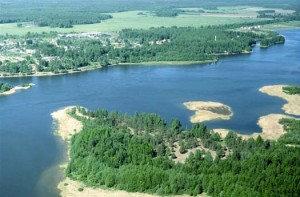- The Vuoksi is a transboundary river that flows 150 km from Lake Saimaa in south-eastern Finland to Lake Ladoga in north-western Russia. The Vuoksi River basin extends between these two lakes and covers an area of 4,100 km2. It is part of the much larger basin through which the Neva River flows to the Baltic Sea.
- Average precipitation in the region is 775 mm per year and the mean annual temperature is around 3.2°C.
The period without frost lasts from April to October. Up to 70% of annual precipitation falls during this period, mostly in August. The total population is about 80,000 people, of whom at least 52,000 live in towns in the Russian part of the basin. - The Vuoksi River has an annual water potential of some 20.4 billion m3. The part of the basin that lies in Finland, although very limited in extent (10% of the overall basin area), contributes almost 94% of the average flow.
- The Vuoksi River basin also contains several freshwater lakes. On both the Russian and Finnish sides of the basin, groundwater resources exist but are of limited capacity (0.03 billion m3 and 0.001 billion m3 per year, respectively).
- The abundance of surface water resources means that meeting water demand is usually not an issue in the Vuoksi River basin. However, during severe droughts, low water levels can affect fish farms, water transport, industrial and household water supply (with intake pipes not reaching the water level), and recreational activities.
- Industry is a leading water user in the Vuoksi River basin. Industrial production in the region grew steadily during the 20th century before declining in the recession of the early 1990s, then started to recover after 1997.
- Access to drinking water is widespread. In towns, more than 80% of residents are connected to centralized cold and hot water infrastructure and sewer networks
- Regarding management of shared waters, since its establishment in 1964 the Finnish-Russian Commission on the use of transboundary watercourses has played a significant role in the Vuoksi River basin. With three working groups, the commission monitors activities that could affect transboundary waters and assesses the compensation required in the event of damage caused by either party.
The section “Did You Know…?” is taken from the 3rd World Water Development Report “Water in a Changing World“.


